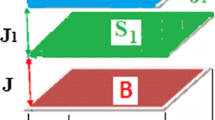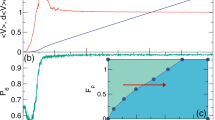Abstract.
Using computer simulations, we study metastability in a two-dimensional Ising ferromagnet relaxing toward a nonequilibrium steady state. The interplay between thermal and nonequilibrium fluctuations induces resonant and scale-invariant phenomena not observed in equilibrium. In particular, we measure noise-enhanced stability of the metastable state in a nonequilibrium environment. The limit of metastability, or pseudospinodal separating the metastable regime from the unstable one, exhibits reentrant behavior as a function of temperature for strong nonequilibrium conditions. Furthermore, when subject to both open boundaries and nonequilibrium fluctuations, the metastable system decays via well-defined avalanches. These exhibit power-law size and lifetime distributions, resembling the scale-free avalanche dynamics observed in real magnets and other complex systems. We expect some of these results to be verifiable in actual (impure) specimens.
Similar content being viewed by others
References
O. Penrose, J.L. Lebowitz, Towards a rigorous molecular theory of metastability, in Fluctuation Phenomena, 2nd edn., edited by E. Montroll, J.L. Lebowitz (North-Holland, Amsterdam, 1987)
J.D. Gunton, M. Droz, Introduction to the theory of metastable and unstable states (Springer, Berlin, 1983)
J.D. Gunton, M. San Miguel, P.S. Sahni, The dynamics of first order phase transitions, in Phase Transitions and Critical Phenomena, edited by C. Domb, J.L. Lebowitz (Academic Press, NY, 1983), Vol. 8
J.S. Langer, An Introduction to the Kinetics of First-Order Phase Transitions, in Solids Far from Equilibrium, edited by C. Godrèche (Cambridge University Press, Cambridge, 1992)
R.H. Schonmann, Commun. Math. Phys. 147, 231 (1992); R.A. Ramos, P.A. Rikvold, M.A. Novotny, Phys. Rev. B 59, 9053 (1999)
J. Marro, J.A. Vacas, Phys. Rev. B 56, 8863 (1997)
M.A. Novotny, Phys. Rev. Lett. 75, 1424 (1995); M. Kolesik, M.A. Novotny, P.A. Rikvold, Phys. Rev. Lett. 80, 3384 (1998)
M. Kolesik, M.A. Novotny, P.A. Rikvold, D.M. Townsley, in Computer Simulation Studies in Condensed Matter Physics X, edited by D.P. Landau, K.K. Mon, H.B. Schüttler (Springer Verlag, Heidelberg 1997), pp. 246-251
P.A. Rikvold, H. Tomita, S. Miyashita, S.W. Sides, Phys. Rev. E 49, 5080 (1994)
P.I. Hurtado, J. Marro, P.L. Garrido, unpublished
E.N.M. Cirillo, J.L. Lebowitz, J. Stat. Phys. 90, 211 (1998); H.L. Richards, M. Kolesik, P.A. Lindgard, P.A. Rikvold, M.A. Novotny, Phys. Rev. B. 55, 11521 (1997)
J. Marro, R. Dickman, Nonequilibrium phase transitions in lattice models (Cambridge University Press, Cambridge 1999)
P.I. Hurtado, P.L. Garrido, J. Marro, Phys. Rev. B 70, 245409 (2004); P.I. Hurtado, J. Marro, P.L. Garrido, Phys. Rev. E 70, 021101 (2004)
R. Mantegna, B. Spagnolo, Phys. Rev. Lett. 75, 563 (1996)
For parameters (T,p,h) such that the mean lifetime is not very large, one can measure τ(T,p,h) using standard Monte Carlo methods. In all cases, results obtained with standard and rejection-free techniques agree perfecly. In particular, the noise-enhanced stability (NES) phenomenon is recovered in standard simulations, ruling out the possibility of NES being an artifact due to the slow-forcing approximation.
The prefix pseudo in pseudospinodal stems from the fact that the metastable-unstable transition is not a sharp transition at h*, but instead it is a progressive crossover from a metastable phase for |h|<h* to an unstable one for |h|>h* (see inset to Fig. 2).
We have also looked for finite-size corrections to the pseudospinodal field by simulating larger systems, finding that these corrections are very small, and can be neglected for all practical purposes.
D. Spasojević, S. Bukvic, S. Milosevic, H.E. Stanley, Phys. Rev. E 54, 2531 (1996)
V. Frette, A. Malthe-Sørenssen, J. Feder, T. Jossang, P. Meakin, Nature 379, 49 (1996)
M. Bahiana, B. Koiller, S.L.A. de Queiroz, J.C. Denardin, L. Sommer, Phys. Rev. E 59, 3884 (1999)
Author information
Authors and Affiliations
Corresponding author
Rights and permissions
About this article
Cite this article
Hurtado, P., Marro, J. & Garrido, P. Stochastic resonance and scale invariance in nonequilibrium metastable states. Eur. Phys. J. B 49, 103–108 (2006). https://doi.org/10.1140/epjb/e2006-00029-9
Received:
Published:
Issue Date:
DOI: https://doi.org/10.1140/epjb/e2006-00029-9




